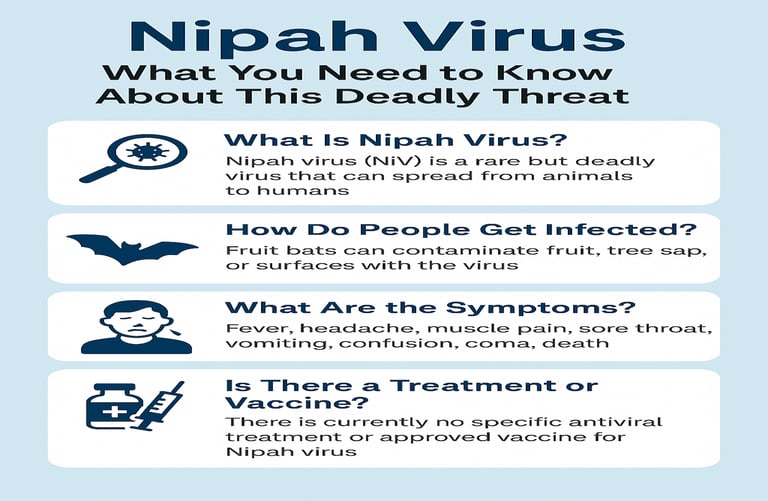Stay updated on what is trending in health. Discover tips and resources for a healthier, balanced life.
Nipah Virus: What You Need to Know About This Deadly Threat
Nipah virus: Symptoms, transmission, outbreaks & prevention. Learn about this deadly zoonotic disease, treatment options, and recent outbreaks. Stay informed.
DISEASES AND CONDITIONS
Dr. S. Ali
9/11/20254 min read


When we think of dangerous viruses, names like Ebola or COVID-19 might come to mind. But there's another deadly virus that doesn't make headlines often—yet it's just as concerning. It's called the Nipah virus.
So, what exactly is Nipah virus? How does it spread? And should you be worried? Let’s break it down in a simple and clear way.
What Is Nipah Virus?
Nipah virus (NiV) is a rare but deadly virus that can spread from animals to humans. It was first identified in 1998 during an outbreak in Malaysia, where it spread from infected pigs to humans. Since then, other outbreaks have occurred in Bangladesh and India, mostly in rural communities.
More recently, a 38-year-old woman in Kerala, India, was tested positive for Nipah virus after contact with a deceased patient, marking Kerala's fourth outbreak since 2018. Authorities identified 387 contacts, imposed containment zones, and closed schools as a precaution. The patient, hospitalized with fever and neurological symptoms, is stable.
Nipah virus, spread by bats, has a high fatality rate, prompting urgent containment efforts.
What makes Nipah virus particularly dangerous is its high fatality rate—between 40% and 75% of people who get infected do not survive. That’s significantly higher than many other viruses we commonly hear about.
How Do People Get Infected?
Nipah virus is primarily spread by fruit bats, which are considered its natural reservoir. These bats can contaminate fruit, tree sap, or surfaces with their saliva, urine, or droppings. When people or animals (like pigs) come into contact with this contaminated material, infection can occur—but not just by casual contact. The virus needs to enter the body, usually through the mouth, nose, eyes, or open cuts on the skin.
Here are the most common ways people get infected:
Eating fruit that has been partially eaten or contaminated by bats
Drinking raw date palm sap that’s been exposed to bat secretions
Direct contact with infected animals, especially pigs, through their secretions or tissues
Close contact with an infected person’s body fluids, such as saliva, respiratory droplets, or urine
Yes, person-to-person transmission is possible, particularly in hospital settings or within households where caregiving and close physical contact increase the risk.
What Are the Symptoms?
Nipah virus infection often starts with general flu-like symptoms, including:
Fever
A sudden high fever is often the first sign of infection, indicating the body is fighting off the virus.Headache
Persistent headaches may occur due to the body's inflammatory response or early involvement of the brain.Muscle pain
Aching muscles can make the body feel weak and tired, similar to what happens during the flu.Sore throat
Throat discomfort or pain may make swallowing difficult and is often accompanied by a hoarse voice.Vomiting or nausea
Some people may experience digestive upset as the virus begins to affect multiple body systems.
As the disease progresses, some people develop more severe and potentially life-threatening symptoms, especially if the virus affects the brain or lungs. These include:
Drowsiness or confusion
This may indicate that the virus has started to affect the brain, leading to changes in mental function or alertness.Seizures
Some patients may experience convulsions as a result of brain inflammation (encephalitis), which is a serious complication.Difficulty breathing
In some cases, the virus can cause acute respiratory distress, making it hard for the person to breathe properly without support.Coma
In the most severe cases, the infection can rapidly lead to a coma, usually due to swelling in the brain. This often occurs within 24 to 48 hours after symptoms of encephalitis appear.Death
Unfortunately, many Nipah cases progress quickly, and the virus has a high fatality rate, particularly if medical care is delayed.
Is There a Treatment or Vaccine?
Unfortunately, there is currently no specific antiviral treatment or approved vaccine for Nipah virus. This means that doctors can’t give a pill or injection to directly kill the virus. Instead, medical care focuses on supportive treatment, which involves managing the patient’s symptoms and preventing complications. This can include giving fluids to prevent dehydration, controlling fever and pain, maintaining oxygen levels, and treating any secondary infections. In severe cases, patients may require intensive care, including ventilator support if breathing becomes difficult. Early diagnosis and supportive care can improve outcomes, but the lack of a targeted cure makes prevention absolutely critical.
Researchers around the world are working on potential vaccines and antiviral medications, but they’re still in the experimental phase. For now, prevention is the best approach.
How Can You Protect Yourself?
If you live in or are traveling to areas where Nipah outbreaks have been reported, here are some simple ways to reduce your risk:
Avoid eating raw or half-eaten fruit, especially if it may have been exposed to bats
Do not drink raw date palm sap, which can be contaminated by bat secretions
Avoid contact with sick animals, particularly pigs
Practice good hygiene and wash hands regularly
Avoid close contact with people showing symptoms during an outbreak
Healthcare workers should use personal protective equipment (PPE) and follow infection control protocols strictly.
Why Is Nipah Virus a Global Concern?
Even though Nipah virus outbreaks are currently limited to certain parts of Asia, health experts around the world are watching it closely. The World Health Organization (WHO) has listed Nipah virus as a priority disease due to its potential to cause future pandemics.
With increasing human-animal interaction, deforestation, and climate change, the risk of new outbreaks in different parts of the world is growing. This is why raising awareness is crucial.
Final Thoughts
The Nipah virus may not be widely known, but it is a serious health threat that deserves attention. While it's not spreading worldwide at the moment, the risk of outbreaks is real—especially in areas where humans and wildlife interact closely.
By staying informed and practicing simple preventive measures, we can reduce the risk of infection and help stop the spread of this dangerous virus before it becomes a global problem.
Knowledge truly is the first step toward prevention.
Sources:
World Health Organization (WHO)Nipah Virus Fact Sheet:
https://www.who.int/news-room/fact-sheets/detail/nipah-virusWorld Health Organization (WHO) Nipah Outbreak Updates:
https://www.who.int/health-topics/nipah-virus-infection
CDC Nipah Virus Page:
https://www.cdc.gov/vhf/nipah/index.htmlPLOS Neglected Tropical Diseases collection
https://journals.plos.org/plosntds/article?id=10.1371/journal.pntd.0007393
The Lancet
https://www.thelancet.com/journals/laninf/article/PIIS1473-3099(24)00765-5/fulltextNature Reviews Microbiology (2020):
https://www.nature.com/articles/s41579-020-00445-zHindustan Times
Pulse Your Health
Empowering you to achieve your health goals.
Contact
© 2025. All rights reserved.
Disclaimer: The content on this website is for informational purposes only and is not medical advice. Always seek the advice of your physician or other suitably qualified healthcare professional for diagnosis, treatment and your health related needs.
